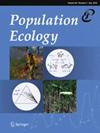Quantifying factors that explain the slopes of the temporal Taylor's law of Hokkaido vole populations
IF 1.1
4区 环境科学与生态学
Q4 ECOLOGY
引用次数: 0
Abstract
Taylor's law (TL) describes the relationship between the variance and mean of population density: log10(variance) ≈ log10(a) + b × log10(mean), a > 0. This study analyzed the temporal TL, for which mean and variance are calculated over time, separately for each population in a collection of populations, considering the effects of the parameters of the Gompertz model (a second‐order autoregressive time‐series model) and the skewness of the density frequency distribution. Time series of 162 populations of the gray‐sided vole in Hokkaido, Japan, spanning 23–31 years, satisfied the temporal TL: log10(variancej) ≈ 0.199 + 1.687 × log10(meanj). This model explained 62% of the variation of log10(variancej). An extended model with explanatory variables log10(meanj), the density‐dependent coefficient for 1‐year lag (α1,j), that for 2‐year lag (α2,j), the density‐independent variability (σj2), and the skewness (γj), explained 93.9% of the log10(variancej) variation. In the extended model, the coefficient of log10(meanj) was 1.949, close to the null value (b = 2) of the TL slope. The standardized partial regression coefficients indicated that density‐independent effects (σj2 and γj) dominated density‐dependent effects (α1,j and α2,j) apart from log10(meanj). The negative correlations observed between σj2 and log10(meanj), and between γj and log10(meanj), played an essential role in explaining the difference between the estimated slope of TL (b = 1.687) and the null slope (b = 2). The effects of those explanatory variables on log10(variancej) were interpreted based on the theory of a second‐order autoregressive time‐series model.量化解释北海道田鼠种群时间泰勒定律斜率的因素
泰勒定律(TL)描述了种群密度的方差和均值之间的关系:log10(方差)≈ log10(a)+ b ×log10(均值),a > 0。本研究对时间 TL 进行了分析,对种群集合中的每个种群分别计算了随时间变化的平均值和方差,并考虑了 Gompertz 模型(二阶自回归时间序列模型)参数和密度频率分布偏度的影响。日本北海道 162 个灰面田鼠种群的时间序列跨度为 23-31 年,符合时间 TL:log10(方差j)≈ 0.199 + 1.687 × log10(均值j)。该模型解释了 log10(方差j)变异的 62%。包含解释变量 log10(meanj)、与密度相关的滞后 1 年系数 (α1,j)、滞后 2 年系数 (α2,j)、与密度无关的变异性 (σj2) 和偏度 (γj)的扩展模型解释了 log10(variancej)变异的 93.9%。在扩展模型中,log10(meanj)系数为 1.949,接近 TL 斜坡的空值(b = 2)。标准化的部分回归系数表明,除 log10(meanj)外,与密度无关的效应(σj2 和 γj)主导与密度有关的效应(α1,j 和 α2,j)。在 σj2 与 log10(meanj)之间以及 γj 与 log10(meanj)之间观察到的负相关在解释 TL 估计斜率(b = 1.687)与无效斜率(b = 2)之间的差异方面发挥了重要作用。这些解释变量对 log10(方差j)的影响是根据二阶自回归时间序列模型理论解释的。
本文章由计算机程序翻译,如有差异,请以英文原文为准。
求助全文
约1分钟内获得全文
求助全文
来源期刊

Population Ecology
环境科学-生态学
CiteScore
3.90
自引率
11.80%
发文量
41
审稿时长
18-36 weeks
期刊介绍:
Population Ecology, formerly known as Researches on Population Ecology launched in Dec 1952, is the official journal of the Society of Population Ecology. Population Ecology publishes original research articles and reviews (including invited reviews) on various aspects of population ecology, from the individual to the community level. Among the specific fields included are population dynamics and distribution, evolutionary ecology, ecological genetics, theoretical models, conservation biology, agroecosystem studies, and bioresource management. Manuscripts should contain new results of empirical and/or theoretical investigations concerning facts, patterns, processes, mechanisms or concepts of population ecology; those purely descriptive in nature are not suitable for this journal. All manuscripts are reviewed anonymously by two or more referees, and the final editorial decision is made by the Chief Editor or an Associate Editor based on the referees'' evaluations.
 求助内容:
求助内容: 应助结果提醒方式:
应助结果提醒方式:


